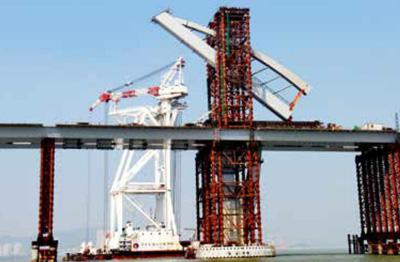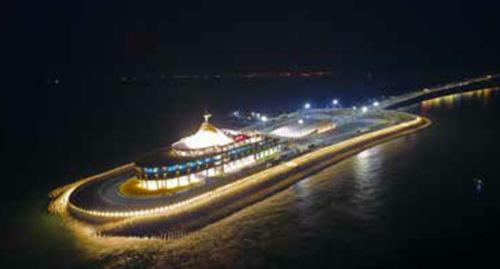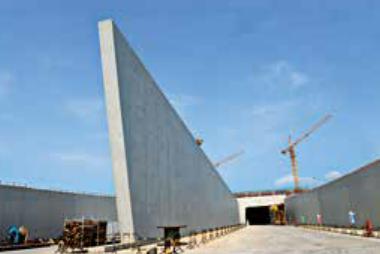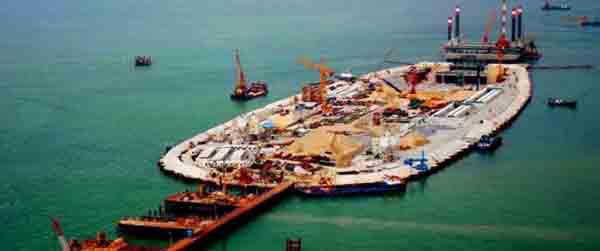Birth of a Modern Marvel
2018-04-11byYangYunqian
by Yang Yunqian



The Hong Kong-Zhuhai-Macao Bridge (HZMB) holds many world records: it is the longest crosssea bridge in the world, and has the longest steel bridge as well as the longest underwater immersed road tunnel. As the most technically challenging highway bridge project with the largest construction scale to date in the history of highways, the difficulty of its construction can be ranked among the highest in the world.
Totaling 55 kilometers, the bridge connects Hong Kongs Lantau Island, the Macao Peninsula and Zhuhai City of Guangdong Province from east to west. After six years of preparation and eight years of construction, the principal section of the bridge is ready for operation after the projects management authority completed an acceptance check in February 2018.
The bridge will cut travel time across the Pearl River Delta—previously four hours by car and one hour by boat—to about half an hour.
Three Sets of Distinctive Bridge Towers
The mega-project consists of three parts overall: the Main Bridge; BoundaryCrossing Facilities for Hong Kong, Zhuhai and Macao; and Link Roads into the three regions. Approaching the Zhuhai end of the bridge features a six-lane highway just past a toll station, overlooking the sea dotted with islands and vessels. Occasionally, Chinese white dolphins leap out of the water.
To name the 29.6-kilometer section cobuilt by the three regional governments “Main Bridge” can be a bit confusing, given the fact that it is a combination of bridges, artificial islands and a tunnel. The scale of the project is often deemed daunting. A case in point would be the 425,000 tons of steel used for deck girders and bridge towers, equivalent to 60 Eiffel Towers. The 22.9-kilometer bridge section includes the Jiuzhou Channel Bridge, Jianghai Channel Bridge, Qingzhou Channel Bridge and a 20-kilometer non-navigable bridge. Over the three channel bridges sit seven towers, shaped like sails, dolphins and Chinese knots, respectively, all adorned with simple patterns that are deeply meaningful.
The Jiuzhou Channel Bridge is the closest to the city proper of Zhuhai. Towering over the Lingdingyang waterway, the “sail” design can be seen from Lovers Road, a landmark thoroughfare along the city coast. Because of its proximity to the Macao airport, buildings were limited to a height of 122 meters, so the two “sails” stand at 120 meters. Jianghais three dolphin-design steel towers were transported and erected on the bridge after construction in a factory, the first time such a strategy was employed in China. “Each steel tower is connected by shafts at its seat,” says Zhang Jinwen, director of engineering of the HZMB Authority. “Lifted by huge steel cables and two floating cranes, the 3,000-ton tower was turned vertically from horizontally to be erected on the bridge in one go, a maneuver that no one had ever attempted before.”
Shaped like two Chinese knots, the Qingzhou Channel Bridge towers are a token of bonding and connection among Hong Kong, Zhuhai and Macao. “It took 100 days to install the Chinese knots because every detail was so important. Only with highprecision installation of each piece came the ultimate successful connection.” Zhang continues. According to him, the Pearl River estuary is a nature reserve for a national protected animal: the Chinese white dolphin. So the towers of the Jianghai Channel Bridge were designed in the shape of dolphins.
Furthermore, the deck surface having been paved in the Main Bridge section totals 700,000 square meters, also the largest project of its kind in the world. When they solicited bids to provide materials for the work, the HZMB procurement team found no qualified company. Good materials are crucial elements of a quality project. So the HZMB Authority proposed the idea of setting up a factory dedicated to producing its aggregates, which resulted in the birth of the most advanced Zhongshan Aggregate Factory.
“Contractors determine the quality of a project,” remarks Gao Xinglin, assistant director of the HZMB Authority and head of its Planning and Contract Department. “The contractors did a better job than we expected. We used uniform-sized aggregates with a low proportion of mud so that our standards stayed on par with international norms.” He believes the HZMB represents an innovation in the field of the countrys bridge surfacing.
Two Shell Islands
About 20 kilometers from the Zhuhai port, past the Qingzhou Channel Bridge sits a western artificial island, which connects to an eastern artificial island towards Hong Kong through an undersea tunnel. Viewed from above, the HZMB resembles two dragons rising from the sea, one winding to the east, the other to the west. The two artificial islands also resemble two round shells or two huge vessels meeting each other halfway.
The two islands have similar buildings but different functions. The eastern island serves as a comprehensive operation center covering transportation, management, services, rescue and tourism. It offers sightseeing platforms and corridors. The western one focuses on monitoring, maintenance and office work.
Completing the tunnel and the two beautiful artificial islands providing transitions from the bridge to tunnel was the most challenging task for the construction team.
The Lingdingyang waterway, under which the tunnel runs, is an important global trade passage that handles 4,000 cargo vessels, fishing boats and passenger ships each day. To guarantee the safety of ships, the height of a bridge must stay above 80 meters and bridge towers 200 meters, but the neighboring Hong Kong International Airport requires nearby buildings to stay lower than 88 meters, dictating the construction of an undersea tunnel. The project required a water obstruction rate of less than 10 percent to prevent mud and sand from accumulating and blocking the waterway, which would result in Lingdingyang becoming a flood plain.
“A 300,000-ton vessel needs to be able to navigate through the bridge alignment, yet airline routes require low buildings and the impact on the environment also needs to be taken into consideration,” explains Zhang Jinwen. “So, this section had to go under the water.”
Undersea Tunnel
The design of the western artificial island eases the drop into the 6.7-kilometer undersea tunnel. Along the undersea landform, the tunnel features two sloped stretches that can hardly be felt while driving. “Inside the tunnel maintains a fixed temperature, and its ventilation system is designed to produce the same conditions as a road tunnel,” explains Zhang Jinwen. “The tunnel is illuminated by LED light, which is suitable for driving.”
This longest road immersed tunnel in the world is composed of 33 prefabricated immersed elements and a 12-meter closure joint that weighs 6,300 tons. The tunnel is 6,700 meters long in total, with the section under the sea extending 5,664 meters. The deepest reaches 46 meters under water.
China is already home to several crosssea bridges, but the HZMB has the countrys largest and deepest immersed tunnel—and in fact, one that immersed the deepest under the seabed in the world.
Workers first dug a groove on the seabed, treated the foundation trench, and then placed the prefabricated immersed elements into the groove before connecting them one by one under the sea. Some projects in other parts of the world have also used such a method, but the tunnel elements for this project were placed far deeper under the seabed. The HZMB project marked the worlds first deep-immersed underwater tunnel because of strict environmental requirements and consideration for surrounding transportation.
It was previously considered a technological taboo to bury tunnels deep in the soil under water as deep as 40 meters. So this section presented the greatest challenge of the HZMB project. To make sure the tunnel can withstand the pressure of the 30-meter-deep mud, its builders managed to precast concrete structures of a million cubic meters free of cracks, and created a“half-rigid” tunnel structure—neither utterly rigid nor flexible by creating different shear forces at different points with meticulous calculation—which enabled them to make the finished tunnel completely waterproof.
But actually placing and connecting these elements 40 meters under the sea with high precision was excruciatingly difficult and required accurate remote control, calculation and computing comparable to spacecraft docking. The construction team set up a Global Navigation Satellite System(GNSS) base station, collecting data from 20,000 meters above sky to guide the project and control the error range to within seven centimeters when connecting the elements. After the elements were connected, water stops at the elements ends were sealed under water pressure.
From immersing the first tunnel element in May 2013 to installing the closure joint in May 2017, immersion of the tunnel structure took as long as four years. On June 7, 2017, the undersea tunnel was passable for construction vehicles. “This project features 64 innovations that bridged many technological gaps,” notes Lin Ming, chief engineer of the HZMBs island and tunnel project with China Communications Construction Co., Ltd. The tunnel has drawn great attention from engineering institutions around the planet and has been referred to as a “Bridge Marvel.”
An Industrial Revolution
Out of the eastern artificial island and at the transition part to the undersea tunnel, Hong Kongs Lantau Island can be seen clearly.
Built jointly by Hong Kong, Zhuhai and Macao, the HZMB had to meet the technological and quality standards of all three regions. Accordingly, the HZMB Authority developed its own design, management and construction methods. The project is designed to last for 120 years and withstand an 8-magnitude earthquake as well as super typhoon. Additionally, both 300,000-ton oil tankers and 150,000-ton cargo vessels can pass over the tunnel and under the bridge at any time.

With regard to bridge construction, many have noted that Europe and the United States dominated the 1960s and 70s before Japan took the torch in the 1980s and 90s. Now its Chinas turn.
“Many companies considered the HZMB project a historic opportunity, so the project attracted elite global resources and promoted industrial development,” says Gao Xinglin.
To protect Chinese white dolphins, environmental protection groups made 300 expeditions and took 300,000 photos which served as reference points for protective measures added to the project.
To prevent workers from falling victim to occupational maladies, the security and environmental protection department provided physical examinations before and after workers terms of employment.
According to incomplete statistics, the engineering marvel has involved 1,000 research institutions and over 1,000 scientific and technical workers since 2003. Early participants carried out 300 research missions, invested 500 million yuan, created over 40 new construction methods, won over 100 patents, compiled 63 manuals for technical standards and regulations and published more than 500 essays as well as a dozen technical monographs.
The project marks the heydays of Chinese infrastructure construction. Almost all contractors involved in the HZMB felt lucky to have seized the chance to participate in the historic project.
From a birds-eye view over the blue Lingdingyang, the rolling bridge appears like a pearl necklace and the two artificial islands like two pieces of jade, giving the bridge the aura of “pearls and jade—a perfect pair.”The country just proposed the concept of a Greater Bay Area around Guangdong Province, Hong Kong and Macao, and the HZMB is expected to play an important role in the future development of the region. “Riding Chinas impressive national development as of late, the economy of the Pearl River Delta continues to grow fast, and both Hong Kong and Macao aspire to reap the rewards of the countrys further development,” notes Yu Lie, deputy director of the HZMB Authority. “Infrastructure connectivity around the bay area will definitely accelerate the process.”